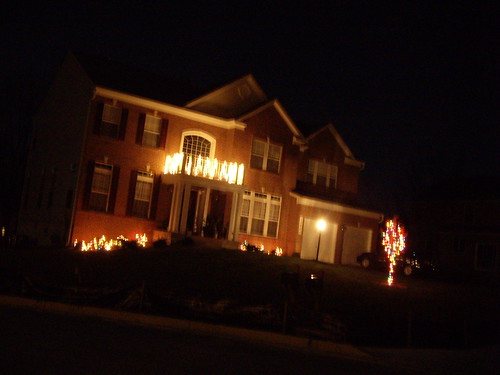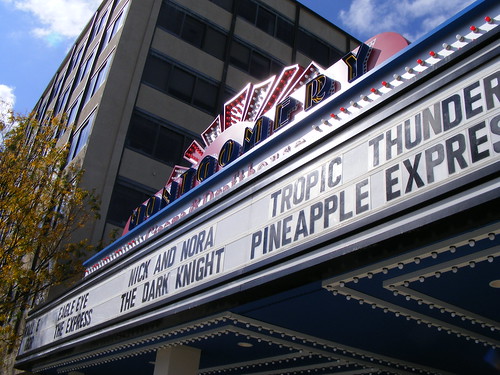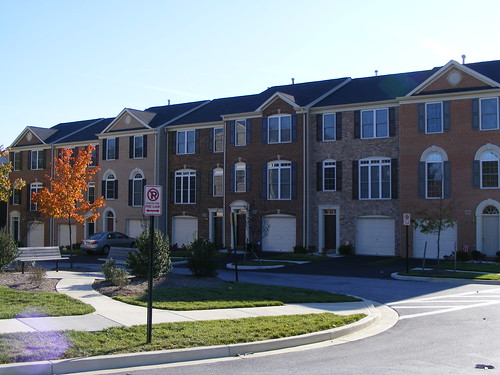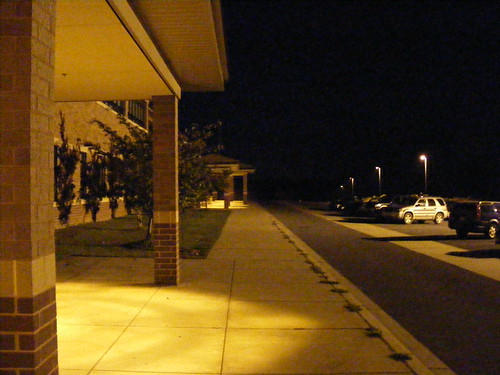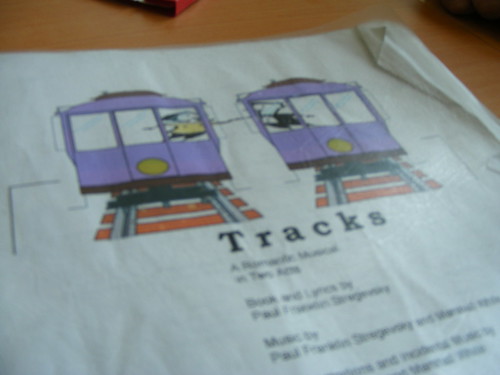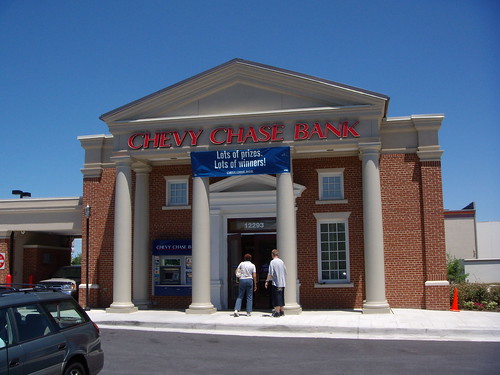2008 will be remembered as an epic year for our nation, with an economic meltdown and the election of our first black president merely the icing on the cake. It's been an epic year for East County as well, with the tragic loss of a County Councilmember and the beginning of construction on the ICC - two things that many people wouldn't have predicted even last year. Here's a look at some of the big stories we've reported on over the past twelve months:
JANUARY:
- Washington Adventist Hospital unveils its plans to build a new facility in Calverton, which will bring over two thousand jobs to East County according to president Jere Stocks.
- Montgomery County signed a lease with concert promoter Live Nation to build a Fillmore music hall in the former J.C. Penney building on Colesville Road, making the controversial nightclub more or less a done deal. It should open in 2010.
FEBRUARY
- Four-term Councilmember Marilyn Praisner, a resident of Calverton for forty years, and Planning Board commissioner Gene Lynch, who was instrumental in the revitalization of Downtown Silver Spring, pass away on the same day.
- A fire breaks out at El Pollo Rico, the popular Peruvian restaurant in Wheaton, damaging several other neighboring businesses.
MARCH:
- The campaign to fill Marilyn Praisner's former County Council seat is on, with four Democrats and four Republicans vying for the position. Many elected officials throw their support behind Praisner's widower, Don, though he faces stiff competition from School Board president Nancy Navarro.
- After his defeat in the Democratic primary to Donna Edwards, Congressman Al Wynn (D-Dist. 4) steps down to take a position at a law firm with less than a year left in his term.
- The Dutch Country Farmers' Market, an institution in Burtonsville, signs a twenty-five-year lease for a space in Laurel after being evicted from their current location by Chris Jones, who planned to redevelop the shopping center it was located in.
APRIL:
- In the primary election to fill the recently-departed Marilyn Praisner's County Council seat, the Democratic nomination goes to her widower Don. Aided by political gadfly Robin Ficker, Mark Fennel wins the Republican nomination.
- The Planning Board adopts the Silver Spring CBD Green Space Plan, which seeks to create new, higher-quality parks and squares throughout the business district.
MAY:
- Don Praisner wins the County Council District 4 election, replacing his wife Marilyn. In keeping with one of her favorite traditions, Don throws an ice cream social at Seibel's Restaurant in Burtonsville.
- The Planning Board approves the Ashton Meeting Place, a proposed mixed-use shopping center in Ashton, the result of a compromise between the developer and residents of the three-hundred-year-old village, who were concerned about the project's scale and context.
JUNE:
- South Silver Spring holds its second-annual Block Party, attempting to re-cast the former industrial neighborhood as a place for arts, music and great food.
- The Fairland Recreation Center and Fairland Library are re-named after former Councilmember Marilyn Praisner, who fought to have both facilities funded and built in the 1990's.
- Burtonsville residents debate traffic, "undesirables" and the future of their community at a charrette for the Community Legacy Plan, which will use state funding to revitalize the beleaguered Burtonsville business district.
JULY:
- International Downtown Associates, a worldwide network of urban planners and designers, propose building a library and town square to revitalize Wheaton's business district, while the Planning Department begins revising the twenty-year-old Wheaton CBD sector plan.
- WMATA proposes expanding their MetroExtra network of rapid buses with a series of new routes throughout the region, including lines along Route 29, Georgia Avenue, New Hampshire Avenue, University Boulevard and East-West Highway. The East County routes could be up and running as early as 2012.
- Montgomery County throws a "farewell party" for "the Turf," the popular fake-grass hangout at Fenton and Ellsworth in Downtown Silver Spring. Over the next two years, it will be transformed into Veterans' Plaza, a paved square featuring a new civic center and ice rink.
AUGUST:
- Construction of the InterCounty Connector begins in earnest as trees come down along Route 29 in preparation for a new interchange. Dogwood Drive in Briggs Chaney is closed to accomodate the toll road, which is set to be completed by 2012.
- Despite making plans to move to Laurel, the Dutch Country Farmers' Market says it will remain in Burtonsville for the time being - which it later revises to "indefinitely." Chris Jones, who plans to redevelop the shopping center the market is located in, is reportedly unable to get the necessary building permits.
- The kids who used to congregate on "the Turf" instead move to the adjacent block of Ellsworth Drive, while landscape architects wonder if the unexpectedly-popular expanse of fake grass could cost them their jobs.
SEPTEMBER:
- The Planning Board decides not to landmark Falkland Chase, instead approving plans to redevelop a third of the New Deal-era apartment complex.
- County Executive Ike Leggett's "Pedestrian Safety Week" gets off to a rough start as he stumbles upon the crime scene for a pedestrian killed on Fairland Road. In response, the county Department of Transportation launches an in-depth examination of pedestrian safety along the road.
- East County residents flock to the eighteenth-annual Burtonsville Days festival, featuring a parade, a food court, local vendors and the first-ever Burtonsville Fashion Show.
OCTOBER:
- Following last June's charrette, consultants propose new landscaping, reconfigured parking lots and minor aesthetic improvements for Burtonsville's struggling village center in the Community Legacy Plan, which can be used to apply for State funding.
- The County Council approves a raft of new amendments that give developers increased leeway in exchange for building the Fillmore music hall and similar amenities in the downtowns of Silver Spring, Bethesda and Wheaton.
- Silver Spring, Singular and Thayer Avenue host Silver Spring's first Zombie Walk, drawing hundreds to Ellsworth Drive and landing a feature in the Gazette.
NOVEMBER:
- Fourteen-year-old Tai Lam, a student at Blair High School, is murdered on a Ride-On bus while coming home from Downtown Silver Spring. While the neighborhood listservs light up with fears that the Purple Line and development will contribute to a rising crime rate, friends and well-wishers set up a memorial to Lam on Ellsworth Drive.
- A bank robbery in Clarksville leads to a police chase across the river into East County, resulting in roadblocks, schools under lockdown and a violent shootout in the Greencastle Lakes neighborhood of Burtonsville.
- Elected officials and local residents alike make themselves heard at Montgomery College for the last of four public hearings on the Purple Line's Alternatives Analysis/Draft Environmental Impact Study.
- Over Thanksgiving weekend, a middle-aged woman vandalizes the exterior of City Place Mall, breaking the windows of the Ruby Tuesday restaurant on Colesville Road with a baseball bat.
DECEMBER:
- JUTP does a series profiling Paul Stregevsky, writer of Tracks, the world's first musical about the Purple Line.
- Ten months after its original location on Ennalls Avenue in Wheaton burned down, Peruvian chicken eatery El Pollo Rico re-opens a block away on University Boulevard, though I still have yet to eat there.
- Councilmember Marc Elrich unveils his plan for a 100-mile Bus Rapid Transit system in Montgomery County, which would create a reserved, reversible lane for buses on major roads like Georgia Avenue, Route 29 and Randolph Road.
- The County's Office of Legislative Oversight says that the Northeast and Downcounty consortia, which offer East County students a choice of "signature programs" at one of eight different high schools, has failed its originally stated goal of racial integration.
- Two months after it opens, the Montgomery Cinema 'N' Drafthouse in Wheaton closes, citing financial difficulties, a lack of help from Montgomery County, and very unrealistic expectations from their landlord, the Westfield Group.
- The Planning Board endorses light-rail as their preferred mode for the Purple Line, and suggests using both the Georgetown Branch Trail in Chevy Chase and Wayne Avenue in East Silver Spring for the route.
- A man is shot outside of Wheaton Plaza two days before Christmas, marking the fourth serious crime that has happened at the mall since its multi-million-dollar renovation in 2005.
JANUARY:
- Washington Adventist Hospital unveils its plans to build a new facility in Calverton, which will bring over two thousand jobs to East County according to president Jere Stocks.
- Montgomery County signed a lease with concert promoter Live Nation to build a Fillmore music hall in the former J.C. Penney building on Colesville Road, making the controversial nightclub more or less a done deal. It should open in 2010.
FEBRUARY
- Four-term Councilmember Marilyn Praisner, a resident of Calverton for forty years, and Planning Board commissioner Gene Lynch, who was instrumental in the revitalization of Downtown Silver Spring, pass away on the same day.
- A fire breaks out at El Pollo Rico, the popular Peruvian restaurant in Wheaton, damaging several other neighboring businesses.
MARCH:
- The campaign to fill Marilyn Praisner's former County Council seat is on, with four Democrats and four Republicans vying for the position. Many elected officials throw their support behind Praisner's widower, Don, though he faces stiff competition from School Board president Nancy Navarro.
- After his defeat in the Democratic primary to Donna Edwards, Congressman Al Wynn (D-Dist. 4) steps down to take a position at a law firm with less than a year left in his term.
- The Dutch Country Farmers' Market, an institution in Burtonsville, signs a twenty-five-year lease for a space in Laurel after being evicted from their current location by Chris Jones, who planned to redevelop the shopping center it was located in.
APRIL:
- In the primary election to fill the recently-departed Marilyn Praisner's County Council seat, the Democratic nomination goes to her widower Don. Aided by political gadfly Robin Ficker, Mark Fennel wins the Republican nomination.
- The Planning Board adopts the Silver Spring CBD Green Space Plan, which seeks to create new, higher-quality parks and squares throughout the business district.
MAY:
- Don Praisner wins the County Council District 4 election, replacing his wife Marilyn. In keeping with one of her favorite traditions, Don throws an ice cream social at Seibel's Restaurant in Burtonsville.
- The Planning Board approves the Ashton Meeting Place, a proposed mixed-use shopping center in Ashton, the result of a compromise between the developer and residents of the three-hundred-year-old village, who were concerned about the project's scale and context.
JUNE:
- South Silver Spring holds its second-annual Block Party, attempting to re-cast the former industrial neighborhood as a place for arts, music and great food.
- The Fairland Recreation Center and Fairland Library are re-named after former Councilmember Marilyn Praisner, who fought to have both facilities funded and built in the 1990's.
- Burtonsville residents debate traffic, "undesirables" and the future of their community at a charrette for the Community Legacy Plan, which will use state funding to revitalize the beleaguered Burtonsville business district.
JULY:
- International Downtown Associates, a worldwide network of urban planners and designers, propose building a library and town square to revitalize Wheaton's business district, while the Planning Department begins revising the twenty-year-old Wheaton CBD sector plan.
- WMATA proposes expanding their MetroExtra network of rapid buses with a series of new routes throughout the region, including lines along Route 29, Georgia Avenue, New Hampshire Avenue, University Boulevard and East-West Highway. The East County routes could be up and running as early as 2012.
- Montgomery County throws a "farewell party" for "the Turf," the popular fake-grass hangout at Fenton and Ellsworth in Downtown Silver Spring. Over the next two years, it will be transformed into Veterans' Plaza, a paved square featuring a new civic center and ice rink.
AUGUST:
- Construction of the InterCounty Connector begins in earnest as trees come down along Route 29 in preparation for a new interchange. Dogwood Drive in Briggs Chaney is closed to accomodate the toll road, which is set to be completed by 2012.
- Despite making plans to move to Laurel, the Dutch Country Farmers' Market says it will remain in Burtonsville for the time being - which it later revises to "indefinitely." Chris Jones, who plans to redevelop the shopping center the market is located in, is reportedly unable to get the necessary building permits.
- The kids who used to congregate on "the Turf" instead move to the adjacent block of Ellsworth Drive, while landscape architects wonder if the unexpectedly-popular expanse of fake grass could cost them their jobs.
SEPTEMBER:
- The Planning Board decides not to landmark Falkland Chase, instead approving plans to redevelop a third of the New Deal-era apartment complex.
- County Executive Ike Leggett's "Pedestrian Safety Week" gets off to a rough start as he stumbles upon the crime scene for a pedestrian killed on Fairland Road. In response, the county Department of Transportation launches an in-depth examination of pedestrian safety along the road.
- East County residents flock to the eighteenth-annual Burtonsville Days festival, featuring a parade, a food court, local vendors and the first-ever Burtonsville Fashion Show.
OCTOBER:
- Following last June's charrette, consultants propose new landscaping, reconfigured parking lots and minor aesthetic improvements for Burtonsville's struggling village center in the Community Legacy Plan, which can be used to apply for State funding.
- The County Council approves a raft of new amendments that give developers increased leeway in exchange for building the Fillmore music hall and similar amenities in the downtowns of Silver Spring, Bethesda and Wheaton.
- Silver Spring, Singular and Thayer Avenue host Silver Spring's first Zombie Walk, drawing hundreds to Ellsworth Drive and landing a feature in the Gazette.
NOVEMBER:
- Fourteen-year-old Tai Lam, a student at Blair High School, is murdered on a Ride-On bus while coming home from Downtown Silver Spring. While the neighborhood listservs light up with fears that the Purple Line and development will contribute to a rising crime rate, friends and well-wishers set up a memorial to Lam on Ellsworth Drive.
- A bank robbery in Clarksville leads to a police chase across the river into East County, resulting in roadblocks, schools under lockdown and a violent shootout in the Greencastle Lakes neighborhood of Burtonsville.
- Elected officials and local residents alike make themselves heard at Montgomery College for the last of four public hearings on the Purple Line's Alternatives Analysis/Draft Environmental Impact Study.
- Over Thanksgiving weekend, a middle-aged woman vandalizes the exterior of City Place Mall, breaking the windows of the Ruby Tuesday restaurant on Colesville Road with a baseball bat.
DECEMBER:
- JUTP does a series profiling Paul Stregevsky, writer of Tracks, the world's first musical about the Purple Line.
- Ten months after its original location on Ennalls Avenue in Wheaton burned down, Peruvian chicken eatery El Pollo Rico re-opens a block away on University Boulevard, though I still have yet to eat there.
- Councilmember Marc Elrich unveils his plan for a 100-mile Bus Rapid Transit system in Montgomery County, which would create a reserved, reversible lane for buses on major roads like Georgia Avenue, Route 29 and Randolph Road.
- The County's Office of Legislative Oversight says that the Northeast and Downcounty consortia, which offer East County students a choice of "signature programs" at one of eight different high schools, has failed its originally stated goal of racial integration.
- Two months after it opens, the Montgomery Cinema 'N' Drafthouse in Wheaton closes, citing financial difficulties, a lack of help from Montgomery County, and very unrealistic expectations from their landlord, the Westfield Group.
- The Planning Board endorses light-rail as their preferred mode for the Purple Line, and suggests using both the Georgetown Branch Trail in Chevy Chase and Wayne Avenue in East Silver Spring for the route.
- A man is shot outside of Wheaton Plaza two days before Christmas, marking the fourth serious crime that has happened at the mall since its multi-million-dollar renovation in 2005.

